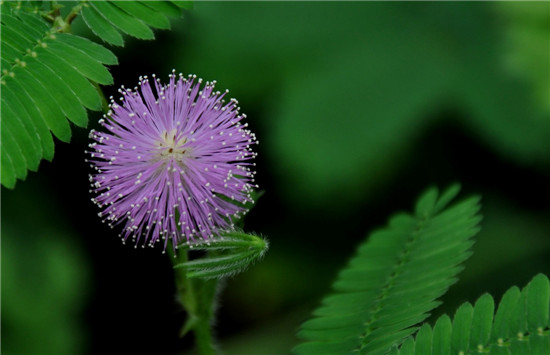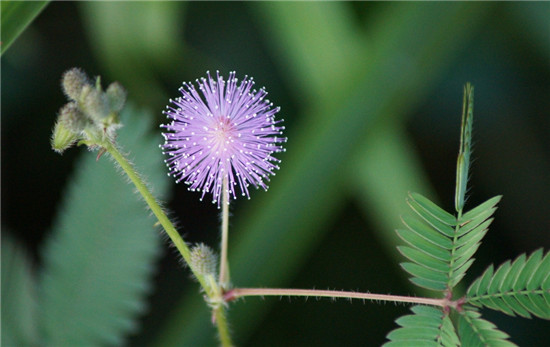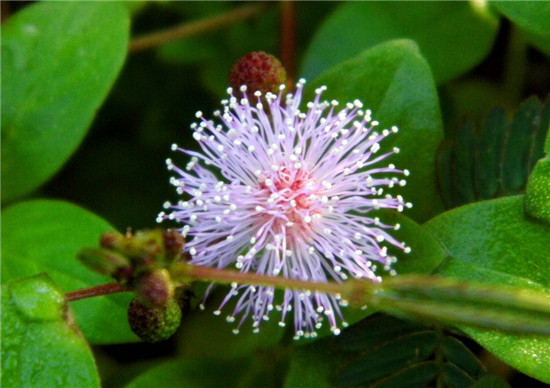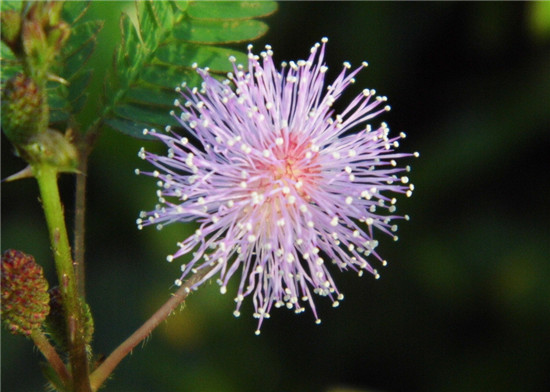Introduction of mimosa in Daquan
I believe many people have seen this plant, it has small leaves, pink globular flowers, touch the leaves will shrink up, that is our common mimosa.

Information on mimosa
The common name of mimosa is "mimosa" and "inductive grass". It is a perennial herb of the genus Mimosa of Leguminosae. Plant height 30-60 cm; stem trailing, much branched, scattered barbed hairs, sharp thorns all over the body; petiole 1.5-4 cm long; stipules lanceolate, spiny; leaves pinnate, 2-colored 4 pieces palmately arranged, leaflet moment rounded, closed and pendulous; flowers many, capitate, generally pink, flowering from July to October; pods flat, margin spiny, 3-4 pods, 2 seeds per node, falling after maturity.
Mimosa is a perennial herb or subshrub of Leguminosae, which is named mimosa because its leaves respond to heat and light and close immediately when touched by external forces. Native to tropical South America, it likes to be warm and humid and has general requirements for soil. The flowers are white and pink, shaped like fluffy balls and delightful. Pods bear fruit after flowering, and the fruit is flat and round. The leaves are feathery and compound leaves are alternate and arranged in palms. The flowers, leaves and pods of mimosa have better ornamental effect, and are easy to survive, so they are suitable for potted flowers in balcony and indoor (human consumption or excessive contact with mimosa will also cause hair loss). It can also be planted in the courtyard and other places. Mimosa is different from other plants in that when touched by people, its petiole is drooping and its small leaves are closed, so people understand it as "shy", so it is called mimosa, mimosa and ugly grass.

Mimosa has strong adaptability, likes to be warm and humid, grows well in moist and fertile soil, is not strict with the soil, is not cold-resistant, likes light, but can withstand semi-shade. General soil can be cultivated, the growth period does not need much fertilizer, dilute liquid fertilizer can be applied for 2-3 times.
Mimosa generally sows and propagates, and sows from late March to early April. Spread the seeds evenly on the fine soil and cover the soil for about 1.5m. When the temperature is about 18 ℃, the seedlings can emerge in about 10 days (generally grow in the soil, no special management is needed). It grows slowly in seedling stage and can be planted at 7-8 cm.
When planting in the field, the plant distance is 25-30 cm, loosen the soil, hoe and water in time. Indoor potted plants, watered once a day in summer. Fertilize once a month, if you do not want to make the plant size too large, it is necessary to reduce the amount of fertilizer, or even do not need to apply fertilizer.

The main function of mimosa
1. Watch. Mimosa plant shape scattered, feather leaves slender and beautiful, its leaves are closed at a touch; mimosa flowers are many and beautiful, charming, giving people the impression of weak and elegant. It can be planted in the corner of the courtyard or potted in the window.
2. For medicinal use. Mimosa is also a medicine. Its nature is slightly cold, sweet and astringent, and has a small poison. It has the effects of tranquilizing, sedation, detoxification, removing blood stasis, relieving pain, clearing heat, diuresis, hemostasis, convergence and so on. it is often used for neurasthenia, injury caused by fall, hemoptysis and herpes zoster. Harvest in summer and autumn, remove weeds, dry or fresh.

3. Predicting earthquakes. According to Turkish seismologist Erjiang, a few hours before a strong earthquake, the leaves of mimosa, which are sensitive to the outside world, suddenly shrink and then wither. In earthquake-prone Japan, scientists have found that under normal circumstances, mimosa leaves open during the day and close at night.
The above is my summary of the information of mimosa, the whole content of the introduction of mimosa, I hope this article can help you. Please continue to follow us.
Related
- Wuhan Hospital Iron Tree Blooming Result Was Instantly Frightened by the Gardener Master
- Which variety of camellia is the most fragrant and best? Which one do you like best?
- What is the small blue coat, the breeding methods and matters needing attention of the succulent plant
- Dormancy time and maintenance management of succulent plants during dormancy
- Minas succulent how to raise, Minas succulent plant pictures
- What are the varieties of winter succulent plants
- How to raise succulent plants in twelve rolls? let's take a look at some experience of breeding twelve rolls.
- Attention should be paid to water control for succulent plants during dormant period (winter and summer)
- Watering experience of twelve rolls of succulent plants
- Techniques for fertilizing succulent plants. An article will let you know how to fertilize succulent plants.



